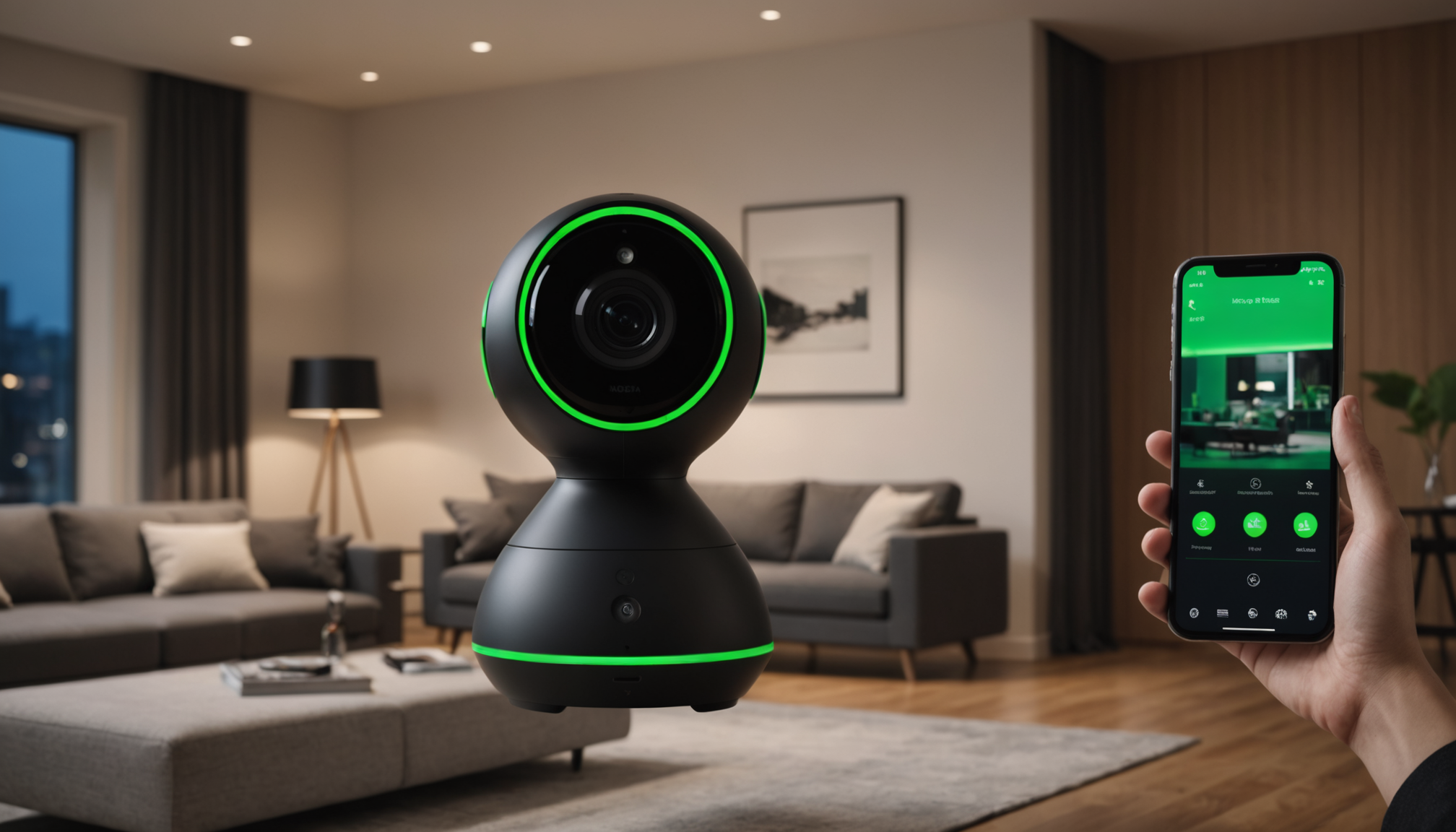Smart home security systems have rapidly become a staple in modern households, offering enhanced protection and peace of mind for homeowners. At their core, these systems integrate advanced technology with traditional home security measures, providing a comprehensive solution to safeguarding your property. Unlike conventional setups, smart home security systems are interconnected through the internet, allowing users to monitor and control their security devices remotely through smartphones, tablets, or computers.
Understanding the components of a smart home security system is crucial for effectively leveraging its capabilities. Generally, these systems encompass a variety of devices designed to work in harmony:
- Cameras: Smart cameras are often the cornerstone of these systems. They provide live video feeds that can be accessed remotely, and often come with features like motion detection, night vision, and in some cases, facial recognition.
- Alarms and Sirens: Unlike traditional alarm systems, smart alarms can notify homeowners of breaches via phone notifications or emails, in addition to setting off a loud siren to deter intruders.
- Smart Locks: These allow users to lock and unlock doors remotely. Features like temporary access codes make it easier to control who has access to your home and when.
- Motion Sensors: Placed around a property, these devices detect movement and can trigger alerts or actions, such as turning on lights, when suspicious activity is detected.
- Environmental Sensors: Some systems include sensors for smoke, carbon monoxide, and water leaks, underscoring the system’s ability to protect against various household hazards.
The integration of artificial intelligence and machine learning is another significant advancement in smart security systems. These technologies enhance the system’s ability to learn typical behavior patterns, allowing it to differentiate between normal and suspicious activities effectively. For instance, AI-driven systems might adapt by learning your daily routine and notifying you only when something out of the ordinary occurs, minimizing false alarms.
Connectivity is at the heart of smart home security, facilitating seamless interaction between devices and users. Most systems rely on Wi-Fi, Bluetooth, or Zigbee protocols, enabling components to communicate effectively. However, when considering a smart system, it is essential to ensure your home network can support the data and connectivity requirements to avoid lagging or connectivity issues, which could compromise security.
To further illustrate the differences among various systems, consider the following table, which provides a basic comparison of several key features:
| Feature | Traditional Security System | Smart Home Security System |
| Remote Monitoring | No | Yes |
| Device Interconnectivity | Low | High |
| Customizability | Limited | Extensive |
| Guest Access Control | No | Yes |
| AI-Driven Alerts | No | Yes |
The evolution of home security into a smart solution presents a compelling preventative measure against various threats, ranging from home intrusions to non-crime-related incidents. Understanding these systems’ capabilities, including their technological underpinnings, is the first step in evaluating the potential safety and convenience they can offer a household.
evaluating the features
 When it comes to examining the central features of smart home security systems, there are several critical components and capabilities that differentiate these modern solutions from traditional security setups. Here’s a closer look at what makes these systems stand out:
When it comes to examining the central features of smart home security systems, there are several critical components and capabilities that differentiate these modern solutions from traditional security setups. Here’s a closer look at what makes these systems stand out:
1. Integration and Compatibility:
– Evaluate the integration capabilities of the security system with other smart home devices. Many systems are designed to work seamlessly with smart assistants like Amazon Alexa, Google Assistant, or Apple HomeKit, enabling voice control and centralized management of all connected devices.
– Check for compatibility with existing devices you may already have, such as smart locks, lights, and thermostats, ensuring a cohesive ecosystem that enhances convenience and functionality.
2. User Interface and Control:
– Smart home security systems usually come with intuitive apps that allow users to manage settings, view camera feeds, and receive notifications. It’s important to assess the user interface’s ease of use and whether it supports multiple users with customized access levels.
– Ensure the app provides real-time alerts and can be easily configured to suit your preferences, such as setting specific times for alerts, defining alert types, and deciding how you want to be notified (e.g., push notifications, emails, texts).
3. Advanced Detection and Alerts:
– Many smart systems incorporate AI technology to enhance detection capabilities. Look for systems that offer intelligent motion detection, which can reduce false alarms by distinguishing between actual threats and harmless activities like a pet moving around.
– Investigate if the system supports geofencing technology, allowing it to arm or disarm automatically based on your proximity to home.
4. Video Analytics:
– Beyond just capturing footage, smart systems with video analytics can provide features like object recognition, which identifies specific items, and line crossing detection, which alerts you if something crosses a predefined line in the camera’s view.
– Consider whether the system supports recording and storing video footage locally or in the cloud and if there are options for reviewing clips selectively through the app.
5. Customizability and Scalability:
– A significant advantage of smart systems is their customizability. Investigate options for adding new devices easily as your needs evolve. For instance, you might start with a basic setup and gradually expand to include additional cameras, sensors, or automation features.
– Assess how scalable the system is — if you move to a larger home or need to cover more areas, the system should adapt without requiring an entirely new setup.
6. Maintenance and Updates:
– Regular software updates are crucial for security and performance enhancements. Check if the system provider offers frequent updates and how these are managed (e.g., automatic updates).
– Understand the maintenance requirements of the components, such as replacing batteries or cleaning lenses, and ensure they are manageable over the long term.
By scrutinizing these features, homeowners can make informed decisions, ensuring that their chosen system not only meets current needs but is also adaptable to future requirements. Thoroughly assessing the capabilities and limitations will help you identify a smart home security solution that optimally balances security concerns with user-friendly innovations.
assessing the cost and subscription models
 When looking at the financial aspects of smart home security systems, it’s crucial to understand the various cost components and subscription models available. This understanding will help you determine the overall affordability and value of these advanced systems, as well as ensure you choose a model that aligns with your budget and needs.
When looking at the financial aspects of smart home security systems, it’s crucial to understand the various cost components and subscription models available. This understanding will help you determine the overall affordability and value of these advanced systems, as well as ensure you choose a model that aligns with your budget and needs.
Firstly, the initial setup cost can vary widely depending on the complexity of the system. Basic kits often include essential components like cameras, motion sensors, and a control panel, with prices ranging from a few hundred to several thousand dollars. While some high-end systems might appear costly upfront, they frequently offer advanced features that could prove cost-effective over time.
Many smart security providers offer flexible subscription plans that cover features such as cloud storage, professional monitoring, and enhanced customer support. These plans typically come with monthly or annual fees, and it’s essential to evaluate whether the features provided justify the ongoing commitment. Some common subscription levels include:
– Basic plans: Offer essential services like basic professional monitoring and cloud storage. They’re usually the most cost-effective option, perfect for users who only need fundamental security coverage.
– Standard plans: Mid-tier options typically add capabilities such as enhanced video analytics, extended cloud storage options, and more frequent system health checks.
– Premium plans: Provide comprehensive services including 24/7 professional monitoring, unlimited cloud storage, video verification, and priority customer support. Although they tend to be more expensive, they often provide peace of mind through robust service offerings.
When assessing costs, consider the long-term savings potential of smart home security systems. Features such as energy-efficient devices and automation can help reduce utility bills. Additionally, many insurance companies offer discounts on home insurance premiums for homes equipped with smart security systems, further enhancing overall financial benefits.
Furthermore, pay attention to hidden costs that might emerge, such as fees for additional devices, upgrades, or early termination of contracts. It’s beneficial to review the fine print of any agreement or contract to avoid unforeseen expenses.
Lastly, the technological advances within these systems can potentially increase home value, appealing to future buyers and making your property more attractive on the real estate market, which can be a significant advantage if you plan to sell your home.
Understanding these financial aspects not only helps in managing your personal finances better but also ensures that you are investing in a solution that offers both upfront and long-term value. By carefully balancing immediate costs with potential long-term savings and additional benefits, you can select a smart home security system that effectively meets your financial and security needs.
comparing traditional vs. smart security
 When weighing the merits of traditional home security systems against smart solutions, it’s important to delve into the core differences that separate these two approaches. Traditional systems often rely on basic alarm panels and motion sensors connected through wired installations. Historically, they’ve been preferred for their reliability and simplistic operation; however, they lack the flexibility and technological advancements that define smart systems today.
When weighing the merits of traditional home security systems against smart solutions, it’s important to delve into the core differences that separate these two approaches. Traditional systems often rely on basic alarm panels and motion sensors connected through wired installations. Historically, they’ve been preferred for their reliability and simplistic operation; however, they lack the flexibility and technological advancements that define smart systems today.
One of the most significant differences lies in customization. Traditional systems typically offer fixed packages with limited room for modification unless one is willing to invest significantly in advanced and often separately-purchased add-ons. Meanwhile, smart security systems excel in their adaptability, allowing homeowners to tailor their setups extensively. This customization includes integrating various smart devices, enabling a personalized security profile that can be fine-tuned as needs evolve. For instance, adding a smart doorbell or extra surveillance cameras to an existing smart system can be accomplished with minimal hassle and often without professional installation.
Another critical comparison can be made in monitoring capabilities. Traditional systems generally rely on third-party monitoring services to respond to alarms, offering little in terms of control to the homeowner beyond arming and disarming the system. Conversely, smart systems empower users to monitor their homes themselves with real-time access to video feeds and alerts via mobile apps. This aspect of immediacy and control is particularly appreciated in today’s fast-paced world, where users seek real-time insights and swift action without relying solely on third-party intervention.
Communication technology serves as another pivotal differentiator. Traditional systems often depend on landline connections to relay alerts to monitoring centers, which can be vulnerable if the lines are cut. In contrast, smart systems utilize a variety of communication protocols such as Wi-Fi, cellular, or Z-Wave, allowing for seamless and uninterrupted alert and communication regardless of external tampering, making them inherently more resilient and reliable.
Furthermore, the integration of artificial intelligence and machine learning into smart systems represents a quantum leap in security technology. These smart systems learn and adapt to detect patterns, significantly reducing false alarms and improving system reliability. A traditional system may only sound an alarm when triggered, whereas a smart system might send a notification of activity that falls outside the user’s established patterns or alert them to unauthorized access attempts on other devices within the network.
Considering efficiency and convenience, smart systems outpace their traditional counterparts by offering automation features. These include setting lights to activate on presence detection or syncing the thermostat’s operation patterns based on geolocation tracking. Traditional systems usually operate without such capabilities, maintaining a static security configuration that doesn’t interact with other home devices.
While both types excel in providing basic protection, the decision often hinges on how much control and adaptability a homeowner desires. Those leaning towards thorough customization, real-time monitoring, and technology-driven solutions often find smart systems more aligned with their needs. Meanwhile, individuals or establishments where simplicity and proven track record are prioritizations might still find solace in traditional setups. As these systems continue to evolve, critically assessing both types’ strengths and limitations becomes ever more essential in making an informed choice that suits individual preferences and lifestyle demands.
making the decision: is it right for you?
 Choosing the right home security system involves a careful assessment of several key factors that align with your personal security needs, lifestyle, and budget. Begin by evaluating the level of convenience and control you desire. Smart home security systems are a perfect fit for those who wish to have real-time monitoring capabilities, immediate notifications, and the flexibility to manage security settings from anywhere. If this appeals to you, then investing in a smart system may be the ideal choice.
Choosing the right home security system involves a careful assessment of several key factors that align with your personal security needs, lifestyle, and budget. Begin by evaluating the level of convenience and control you desire. Smart home security systems are a perfect fit for those who wish to have real-time monitoring capabilities, immediate notifications, and the flexibility to manage security settings from anywhere. If this appeals to you, then investing in a smart system may be the ideal choice.
Take into account the technological aptitude and willingness to engage with advanced features. Smart systems often come with myriad options that may require some tech-savviness to fully utilize. Consider how comfortable you are with integrating technology into your everyday life, as the effectiveness of smart security systems often hinges on how well their features are utilized.
Consider the scalability of your security needs. If you foresee expanding your home or adding more security features down the line, a smart home security system offers unparalleled scalability. These systems can be easily scaled or modified to suit evolving security requirements, providing a future-proof solution that can grow with your needs.
Financial considerations are also a crucial component. Analyze the initial costs and ongoing expenses of smart systems, including subscription fees for cloud storage, professional monitoring, or advanced features. Compare these with your budget and expected long-term savings, such as potential reductions in insurance premiums and enhanced home value. If the modern conveniences and potential savings outweigh the costs, it might be worth considering a smart system.
Lastly, weigh the matter of privacy and data security. Smart systems typically collect and process a significant amount of data, so it’s essential to ensure that the system’s provider employs strong data protection measures. Understanding your comfort level with data sharing and online interactions should inform your choice.
In summary, the decision to adopt a smart home security system depends on your preference for technological convenience and control over your home security settings, your budget and the potential for future modifications, and your comfort with privacy and data security concerns. By carefully considering these factors, you can decide whether smart home security systems are well-suited to your personal circumstances and ultimately determine if they are worth the hype for your household.

